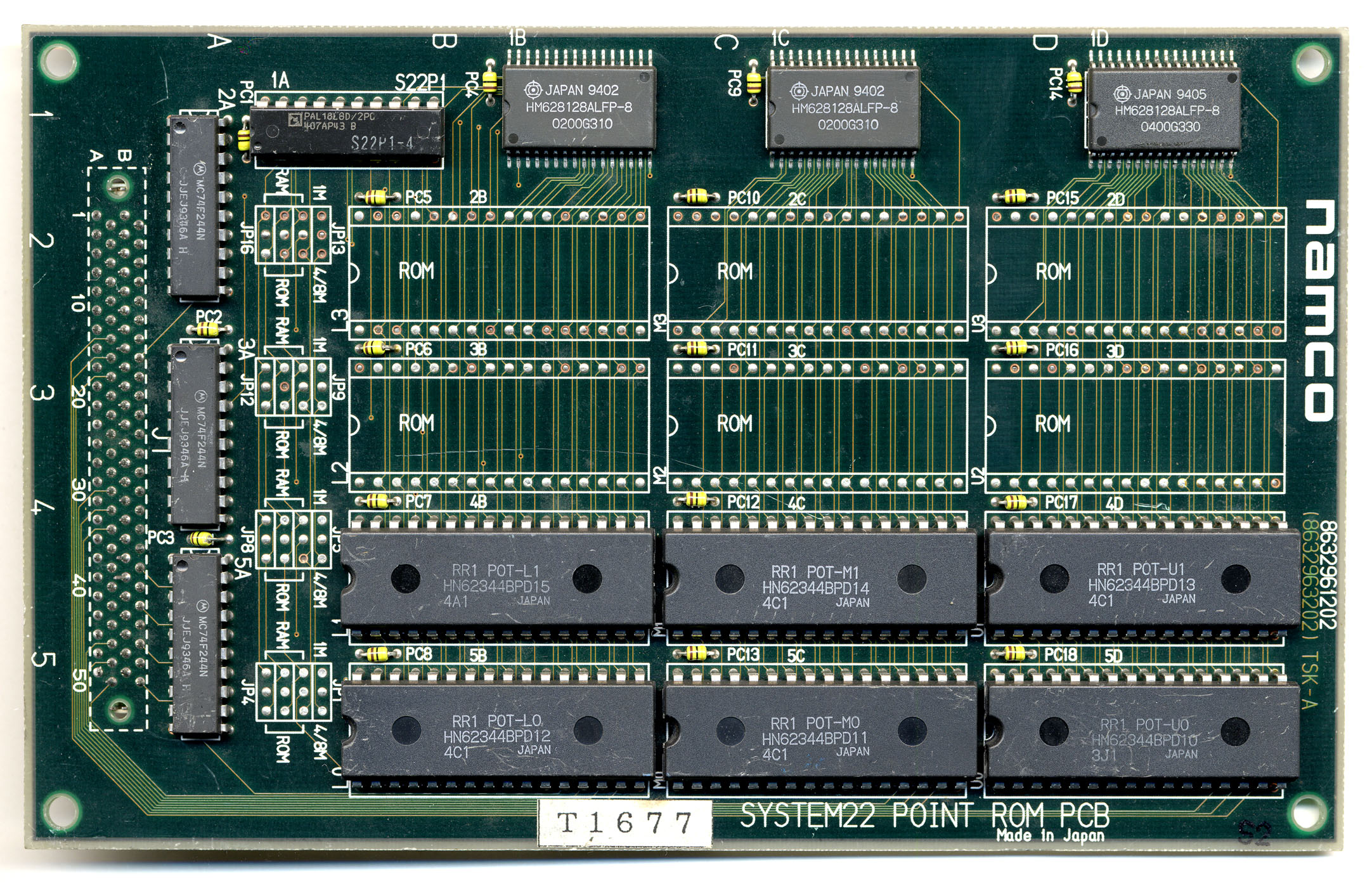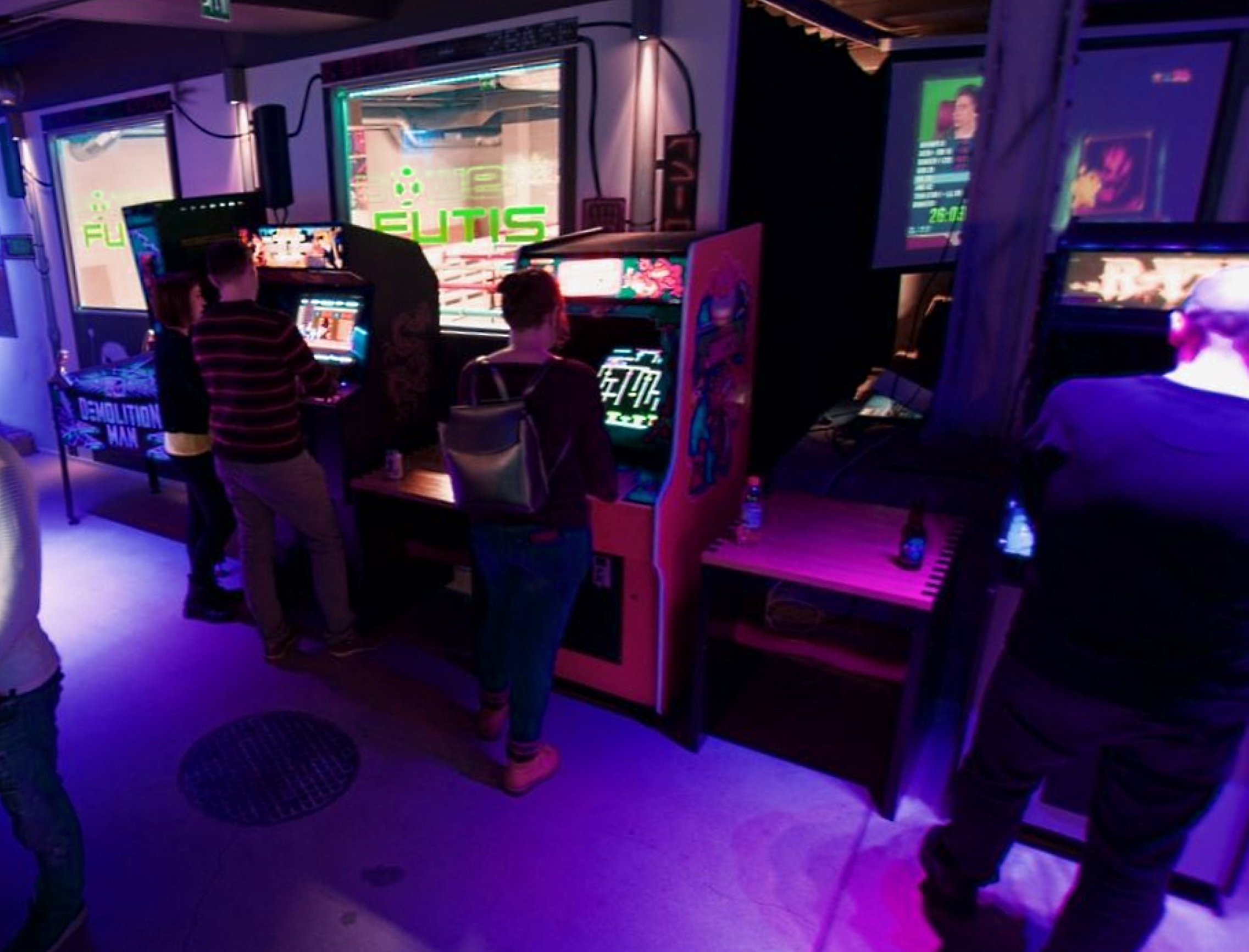|
Cyber Cycles
is a racing arcade game that was released by Namco in 1995. It runs on their System 22 hardware, and allows up to four people to play it simultaneously when two 2-player cabinets are linked together. Gameplay Players must choose one of three different types of motorcycles (the Anthias for novice players, the NVR750R for amateur ones and the Wild Hog for experts). There are also two hidden motorcycles named the NVR750RSP and Back Anthias, that may be activated by entering a code into the cabinet, but it varies based on if the player is red (Player 1) or yellow (Player 3), or black (Player 2) or blue (Player 4). The CPU-controlled green motorcycles in the game are also based on the cycles from 1992's ''Suzuka 8 Hours'', and there are two different circuits to choose from (Green Hill, which is named after one of the circuits of 1993's ''Suzuka 8 Hours 2'' and aimed at novice players, and Neo Yokohama, which is aimed at expert ones) along with seven background music tracks (four ... [...More Info...] [...Related Items...] OR: [Wikipedia] [Google] [Baidu] |
Namco
was a Japanese multinational corporation, multinational video game and entertainment company, headquartered in Ōta, Tokyo. It held several international branches, including Namco America in Santa Clara, California, Namco Europe in London, Namco Taiwan in Kaohsiung, and Shanghai Namco in mainland China. Namco was founded by Masaya Nakamura (businessman), Masaya Nakamura on June 1, 1955, as beginning as an operator of coin-operated amusement rides. After reorganizing to Nakamura Seisakusho Co., Ltd. in 1959, a partnership with Walt Disney Productions provided the company with the resources to expand its operations. In the 1960s, it manufactured Electro-mechanical game, electro-mechanical arcade games such as the 1965 hit ''Periscope (arcade game), Periscope''. It entered the video game industry after acquiring the struggling Japanese division of Atari, Inc., Atari in 1974, distributing games such as ''Breakout (video game), Breakout'' in Japan. The company renamed itself Namco ... [...More Info...] [...Related Items...] OR: [Wikipedia] [Google] [Baidu] |
Racing Video Game
Racing games are a video game genre in which the player participates in a racing competition. They may be based on anything from real-world racing leagues to fantastical settings. They are distributed along a spectrum between more realistic racing simulations and more fantastical arcade-style racing games. Kart racing games emerged in the 1990s as a popular sub-genre of the latter. Racing games may also fall under the category of sports video games. Sub-genres Arcade-style racing Arcade-style racing games put fun and a fast-paced experience above all else, as cars usually compete in unique ways. A key feature of arcade-style racers that specifically distinguishes them from simulation racers is their far more liberal physics. Whereas in real racing (and subsequently, the simulation equivalents) the driver must reduce their speed significantly to take most turns, arcade-style racing games generally encourage the player to "powerslide" the car to allow the player to keep up thei ... [...More Info...] [...Related Items...] OR: [Wikipedia] [Google] [Baidu] |
Arcade Game
An arcade game or coin-op game is a coin-operated entertainment machine typically installed in public businesses such as restaurants, bars and amusement arcades. Most arcade games are presented as primarily games of skill and include arcade video games, Pinball machines, electro-mechanical games, redemption games or merchandisers. Types Broadly, arcade games are nearly always considered games of skill, with only some elements of games of chance. Games that are solely games of chance, like slot machines and pachinko, often are categorized legally as gambling devices and, due to restrictions, may not be made available to minors or without appropriate oversight in many jurisdictions. Arcade video games Arcade video games were first introduced in the early 1970s, with ''Pong'' as the first commercially successful game. Arcade video games use electronic or computerized circuitry to take input from the player and translate that to an electronic display such as a monitor or telev ... [...More Info...] [...Related Items...] OR: [Wikipedia] [Google] [Baidu] |
Namco System 22
The Namco System 22 is the successor to the Namco System 21 arcade system board. It debuted in 1992 with '' Sim Drive'' in Japan, followed by a worldwide debut in 1993 with ''Ridge Racer''. The System 22 was designed by Namco with assistance from graphics & simulation company Evans & Sutherland. Graphical features include texture mapping, Gouraud shading, transparency effects, and depth cueing, thanks to the Evans & Sutherland 'TR3' chip/chipset, which stands for: Texture Mapping, Real-Time, Real-Visual, Rendering System. The main CPU provides a scene description to the TR3 graphics processing unit and a bank of DSP chips which perform 3D calculations. A variant of the system, called the Super System 22, was released in 1995. The hardware was largely similar to the System 22, but with a slightly higher polygon rate and more special effects possible. System 22 Specifications *Main CPU: Motorola 68020 32-bit @ 24.576 MHz *DSP: 2x Texas Instruments TMS32025 @ 49.152& ... [...More Info...] [...Related Items...] OR: [Wikipedia] [Google] [Baidu] |
Arcade Game
An arcade game or coin-op game is a coin-operated entertainment machine typically installed in public businesses such as restaurants, bars and amusement arcades. Most arcade games are presented as primarily games of skill and include arcade video games, Pinball machines, electro-mechanical games, redemption games or merchandisers. Types Broadly, arcade games are nearly always considered games of skill, with only some elements of games of chance. Games that are solely games of chance, like slot machines and pachinko, often are categorized legally as gambling devices and, due to restrictions, may not be made available to minors or without appropriate oversight in many jurisdictions. Arcade video games Arcade video games were first introduced in the early 1970s, with ''Pong'' as the first commercially successful game. Arcade video games use electronic or computerized circuitry to take input from the player and translate that to an electronic display such as a monitor or telev ... [...More Info...] [...Related Items...] OR: [Wikipedia] [Google] [Baidu] |
Electronic Gaming Monthly
''Electronic Gaming Monthly'' (often abbreviated to ''EGM'') is a monthly American video game magazine. It offers video game news, coverage of industry events, interviews with gaming figures, editorial content and product reviews. History The magazine was founded in 1988 as U.S. National Video Game Team's ''Electronic Gaming Monthly'' under Sendai Publications. In 1994, ''EGM'' spun off '' EGM²'', which focused on expanded cheats and tricks (i.e., with maps and guides). It eventually became ''Expert Gamer'' and finally the defunct ''GameNOW''. After 83 issues (up to June 1996), ''EGM'' switched publishers from Sendai Publishing to Ziff Davis. Until January 2009, ''EGM'' only covered gaming on console hardware and software. In 2002, the magazine's subscription increased by more than 25 percent. The magazine was discontinued by Ziff Davis in January 2009, following the sale of '' 1UP.com'' to UGO Networks. The magazine's February 2009 issue was already completed, but was not pu ... [...More Info...] [...Related Items...] OR: [Wikipedia] [Google] [Baidu] |
Suzuka 8 Hours (video Game)
is a 1992 racing game, motorcycle racing arcade game developed and published by Namco. It is based on the homonymous Suzuka 8 Hours, real-world racing event. Players control a racer using a handlebar controller and must race against computer-controlled opponents while remaining in first place. It ran on the Namco System 2 arcade hardware. A direct sequel, ''Suzuka 8 Hours 2'', was released a year later. Gameplay The game was made available in two-player cabinets featuring two monitors and two replica motorcycles; players accelerate their bikes by holding down the throttle grip and brake by using the brake lever, while steering is accomplished by physically leaning the bike left or right. The arcade game can be played by up to eight players simultaneously by linking four two-player cabinets together, and the players must complete an entire lap of the track within a preset time limit - and upon completion of a lap, the time is extended for all players in the race. The first player ... [...More Info...] [...Related Items...] OR: [Wikipedia] [Google] [Baidu] |
Ridge Racer (video Game)
is a 1993 racing video game developed and published by Namco. It was released initially on the Namco System 22 arcade system board and ported to the PlayStation console in 1994. It is the first title in the ''Ridge Racer'' series released for arcades and home consoles. The aim is to finish in first place in a series of races. The PlayStation version supports Namco's NeGcon controller. Development took eight months, and the game is based on a trend among Japanese car enthusiasts, which involves racing on mountain roads while drifting around corners. It was also the first arcade video game with 3D texture-mapped graphics, with its System 22 hardware capable of texture mapping and Gouraud shading. The first home version was released in Japan in 1994 as a launch title for the PlayStation; the versions for North America and Europe were released in 1995, also as a launch title for both regions. It was re-released in Japan for the PlayStation The Best range in 1997, and for the G ... [...More Info...] [...Related Items...] OR: [Wikipedia] [Google] [Baidu] |
Next Generation (magazine)
''Next Generation'' was a video game magazine that was published by Imagine Media (now Future US). It was affiliated to and shared editorial with the UK's ''Edge'' magazine. ''Next Generation'' ran from January 1995 until January 2002. It was published by Jonathan Simpson-Bint and edited by Neil West. Other editors included Chris Charla, Tom Russo, and Blake Fischer. ''Next Generation'' initially covered the 32-bit consoles including 3DO, Atari Jaguar, and the then-still unreleased Sony PlayStation and Sega Saturn. Unlike competitors ''GamePro'' and ''Electronic Gaming Monthly'', the magazine was directed towards a different readership by focusing on the industry itself rather than individual games. Publication history The magazine was first published by GP Publications up until May 1995 when the publisher rebranded as Imagine Media. In September 1999, ''Next Generation'' was redesigned, its cover name shortened to simply ''NextGen''. This would start what was known as "Lif ... [...More Info...] [...Related Items...] OR: [Wikipedia] [Google] [Baidu] |
Future US
Future US, Inc. (formerly known as Imagine Media and The Future Network USA) is an American media corporation specializing in targeted magazines and websites in the video games, music, and technology markets. Headquartered in New York City, the corporation has offices in: Alexandria, Virginia; Minneapolis, Minnesota; and Washington, D.C. Future US is owned by parent company, Future plc, a specialist media company based in Bath, Somerset, England. History The company was established when Future plc acquired struggling Greensboro ( N.C.) video game magazine publisher GP Publications, publisher of ''Game Players'' magazine, in 1994. The company launched a number of titles including ''PC Gamer'', and relocated from North Carolina to the San Francisco Bay Area, occupying various properties in Burlingame and South San Francisco. When Chris Anderson, the founder of Future plc, sold Future to Pearson plc he retained GP, renamed Imagine Media, Inc. in June 1995, and operated it as h ... [...More Info...] [...Related Items...] OR: [Wikipedia] [Google] [Baidu] |
1995 Video Games
File:1995 Events Collage V2.png, From left, clockwise: O.J. Simpson is O. J. Simpson murder case, acquitted of the murders of Nicole Brown Simpson and Ronald Goldman from the 1994, year prior in "The Trial of the Century" in the United States; The Great Hanshin earthquake strikes Kobe, Japan, killing 5,000-6,000 people; The Unabomber Manifesto is published in several U.S. newspapers; Gravestone, Gravestones mark the victims of the Srebrenica massacre near the end of the Bosnian War; Windows 95 is launched by Microsoft for Personal computer, PC; The first exoplanet, 51 Pegasi b, is discovered; Space Shuttle Atlantis docks with the Space station Mir in a display of U.S.-Russian cooperation; The Alfred P. Murrah Federal Building in Oklahoma City is Oklahoma City bombing, bombed by Domestic terrorism in the United States, domestic terrorists, killing 168., 300x300px, thumb rect 0 0 200 200 O. J. Simpson murder case rect 200 0 400 200 Great Hanshin earthquake, Kobe earthquake rect 400 0 6 ... [...More Info...] [...Related Items...] OR: [Wikipedia] [Google] [Baidu] |
Arcade Video Games
Arcade most often refers to: * Arcade game, a coin-operated game machine ** Arcade cabinet, housing which holds an arcade game's hardware ** Arcade system board, a standardized printed circuit board * Amusement arcade, a place with arcade games * Arcade (architecture), a series of adjoining arches * Shopping mall, one or more buildings forming a complex of shops, also sometimes called a shopping arcade Arcade or The Arcade may also refer to: Places Greece *Arcades (Crete), a town and city-state of ancient Crete, Greece Italy * Arcade, Italy, a town and commune in the region of Veneto United States * Arcade Building (Asheville, North Carolina) * Arden-Arcade, California * Arcade, Georgia, a city in Jackson County * Arcade (village), New York * Arcade (town), New York * The Arcade (Oak Bluffs, Massachusetts), a historic site in Oak Bluffs, Massachusetts * The Arcade (Providence, Rhode Island), a historic shopping center * Arcade, Texas Arts and entertainment Books an ... [...More Info...] [...Related Items...] OR: [Wikipedia] [Google] [Baidu] |







